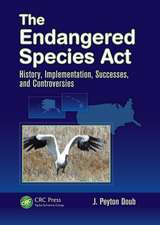Introduction to Integrated Pest Management
Autor M.L. Flint, R. van den Boschen Limba Engleză Paperback – 22 ian 2012
Preț: 638.11 lei
Preț vechi: 750.72 lei
-15% Nou
Puncte Express: 957
Preț estimativ în valută:
122.13€ • 125.86$ • 103.11£
122.13€ • 125.86$ • 103.11£
Carte tipărită la comandă
Livrare economică 03-17 martie
Preluare comenzi: 021 569.72.76
Specificații
ISBN-13: 9781461592143
ISBN-10: 1461592143
Pagini: 260
Ilustrații: 256 p.
Dimensiuni: 152 x 229 x 14 mm
Greutate: 0.35 kg
Ediția:Softcover reprint of the original 1st ed. 1981
Editura: Springer Us
Colecția Springer
Locul publicării:New York, NY, United States
ISBN-10: 1461592143
Pagini: 260
Ilustrații: 256 p.
Dimensiuni: 152 x 229 x 14 mm
Greutate: 0.35 kg
Ediția:Softcover reprint of the original 1st ed. 1981
Editura: Springer Us
Colecția Springer
Locul publicării:New York, NY, United States
Public țintă
ResearchCuprins
1 Man, Pests, and the Evolution of Ipm: an Introduction.- 2 Human-Managed Environments as Systems within the Biosphere.- The Biosphere.- Communities and Ecosystems.- Human-Managed Ecosystems.- 3 What is a Pest?.- Economic Loss is Primarily a Function of Population Density.- Placing Pests on the Food Chain.- Kinds of Pests 45 Entomophobia.- 4 A History of Pest Control.- Early Pest Control—From Prehistoric Times to the Renaissance.- The Renaissance and the Agricultural Revolution.- The Early Twentieth Century.- After World War II—The Revolutionizing of Pest Control by DDT and Other Synthetic Organic Pesticides.- The Development of Integrated Pest Management.- 5 The Cost of Pest Control: Economic, Social, and Environmental.- The Private Economics of Pest Management.- Conflicts of Interest in Ecosystem Management.- The Societal Implications of Pest Management Decisions.- Environmental Quality 98 Hazard to Health.- 6 The Philosophy of Integrated Pest Management: The Strategy of the Future.- A Guide for Setting Up an Integrated Pest Management Program.- 7 Practical Procedures: Ipm Monitoring, Decision-Making, and the Tools and Techniques of the Integrated Pest Manager.- Monitoring and Sampling; Data Collection: Reading the Pulse of the Ecosystem.- Control Action Levels and Other Decision-Making Guides.- Integrated Pest Management Options.- 8 Case Histories in Integrated Pest Management.- Alfalfa in California.- Integrated Pest Management in Apples in Nova Scotia.- Integrated Pest Management in North Carolina Flue-Cured Tobacco.- Integrated Pest Management in Cotton in the San Joaquin Valley of California.- Integrated Pest Management of Mosquitoes in a California Salt Marsh.- Integrated Pest Management of Urban Street Tree Pests.- Integrated Pest Management in Citrus inthe San Joaquin Valley of California.- Integrated Pest Management in Pears.- 9 The Integrated Pest Management Specialist.- 10 The Future of Integrated Pest Management.












